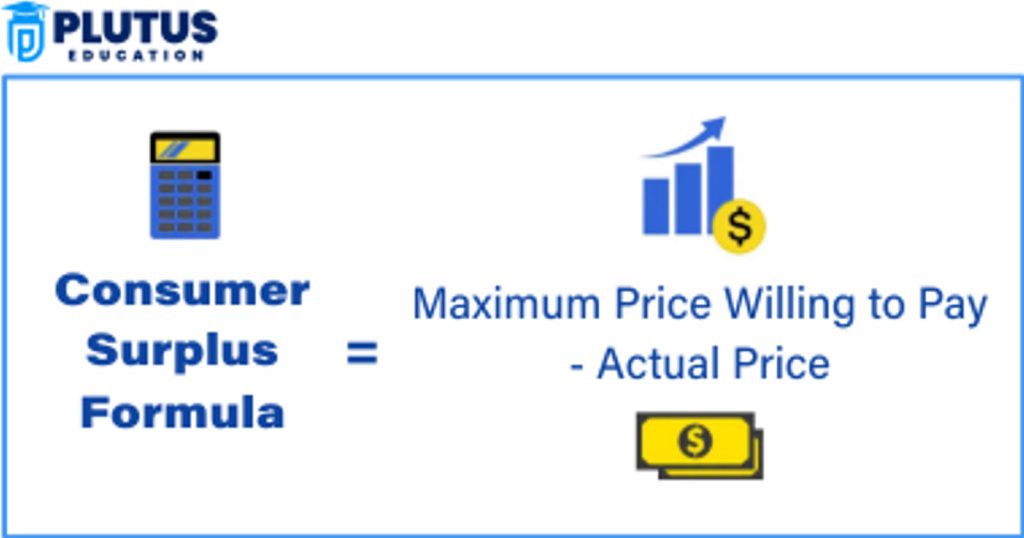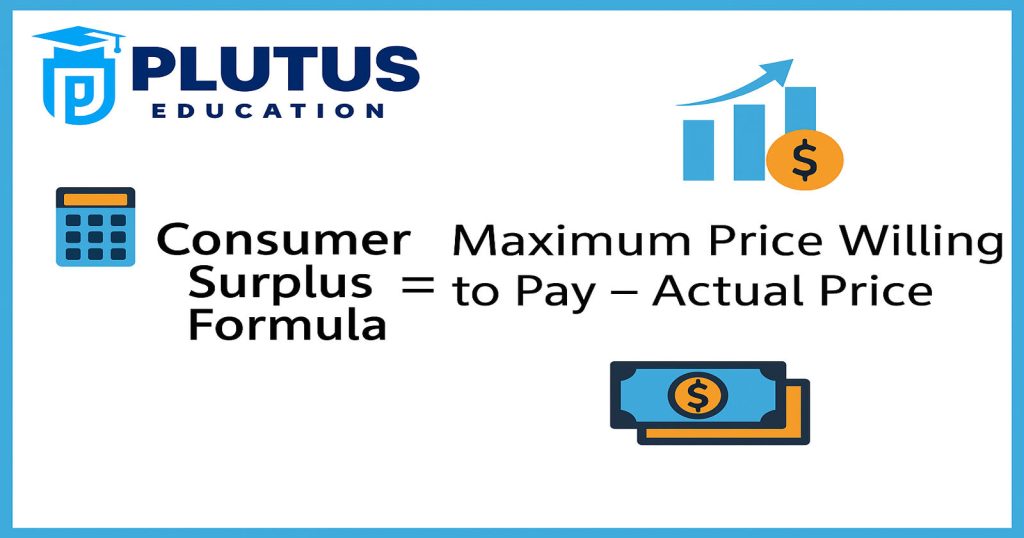The consumer surplus formula helps understand the benefit a buyer receives when they pay less than they are willing to pay. Simply put, consumer surplus shows the difference between what a consumer is ready to pay and what they pay. It is a key part of economic studies and helps to know how markets work. The formula is helpful in various areas like policymaking, pricing strategy, and understanding market changes. It is also a significant part of understanding consumer behavior and demand. The economic consumer surplus formula uses graphs, calculus, or simple pricing to find the value.
What is the Consumer Surplus?
Consumer surplus is the extra value or benefit from buying a product at a price lower than the maximum they were willing to pay. It shows how happy or satisfied a consumer feels after a purchase. This gap becomes the consumer surplus when the market price exceeds what the buyer is ready to pay. This surplus explains why buyers think they got a good deal.
Understanding the Basic Meaning of Consumer Surplus
Consumer surplus means savings for the buyer. If a student wants to buy a book for ₹500 but finds it for ₹300, then the consumer surplus is ₹200. The student paid less and gained value. Many such buyers in the market create a large consumer surplus. This shows how much benefit the market gives to buyers. Consumer surplus is a big part of how the economy works. When prices go down, consumer surplus goes up. This makes people feel they saved money. When prices go up, surplus goes down, and buyers may feel less happy. So, understanding this surplus helps in seeing how pricing affects consumers.
Consumer surplus also shows how well the market works. If the market gives a high consumer surplus, prices are reasonable for buyers. If the surplus is low, it may mean the market has problems like high prices or less competition. So, the consumer surplus formula helps study all these changes.
Economic Theory Behind Consumer Surplus
Consumer surplus comes from demand and utility theory in economics. The idea is that people buy goods to gain utility or satisfaction. They are ready to pay a high price for the first unit, but their need decreases with each extra unit. This shows how demand drops as quantity goes up.
Marginal Utility and Demand Curve
The economic idea behind consumer surplus is marginal utility. Marginal utility means the extra happiness or satisfaction from buying one more unit. As people buy more, marginal utility becomes less. This is called the law of diminishing marginal utility.
Because of this, people are ready to pay more for the first unit and less for the next. This creates a downward sloping demand curve. The consumer surplus is the top part of the demand curve, above the market price. This area between the demand curve and the market price shows the total gain to all buyers.
Demand and Market Price Interaction
In the real market, many buyers pay one price, but each buyer values the product differently. Some people may be ready to pay more, and some may pay only the market price. So, the consumer surplus is he extra amount saved by buyers who would pay more. The demand curve tells us how much quantity people buy at different prices. Using this curve, economists find the area that shows consumer surplus. This area shows how many buyers gain from the current price. The theory also helps compare this gain with what producers get, called producer surplus.
People learn how consumer behaviour, pricing, and utility are linked using the consumer surplus formula in economics. When policy changes or taxes happen, the theory helps predict how consumer surplus will change.

Calculating the Consumer Surplus
A proper method or formula must be used to find the consumer surplus. The consumer surplus formula uses simple math or advanced tools like calculus. It depends on how the demand is shown: with a straight line, graph, or equation.
Simple Consumer Surplus Formula
When the demand curve is straight, use this basic formula:
Consumer Surplus = ½ × (Maximum Price – Market Price) × Quantity
This is like finding the area of a triangle. It fits well when demand is linear and the market price is clear. Here’s a small table to explain:
| Max Price (₹) | Market Price (₹) | Quantity | Consumer Surplus (₹) |
| 100 | 60 | 10 | ½ × (100-60) × 10 = 200 |
This table shows how buyers gain ₹200 by paying less.
Using Calculus in the Consumer Surplus Formula
For more exact values, use the consumer surplus formula in calculus. In this case:
Consumer Surplus = ∫ from 0 to Q (D(q) dq) – (P × Q)
D(q) is the demand function, P is the price, and Q is the quantity. This finds the area under the demand curve and subtracts the total amount paid.
Consumer Surplus Formula from Demand Function
If demand is a function, say D(q) = 100 – 2q, and market price is ₹40, find where D(q) = 40:
100 – 2q = 40 → q = 30
Then apply:
From 0 to 30 (100 – 2q dq) – (40 × 30)
= [100q – q²] from 0 to 30 – 1200
= (3000 – 900) – 1200 = 900
So, consumer surplus = ₹900. This consumer surplus formula from the demand function helps in exact answers. Using the change in consumer surplus formula, small price or quantity changes show how surplus increases or decreases. This helps in seeing what policies or taxes do to buyers.

Factors Affecting Consumer Surplus
Many reasons change the value of consumer surplus. Some are in buyer behaviour, others in market price or product type. Understanding these helps firms and the government make intelligent decisions.
Price Changes
The biggest reason for change is price. If the price goes down, buyers gain more. The gap between what they would pay and what they pay becomes larger. This increases consumer surplus. If the price goes up, the surplus becomes small or even zero.
Income and Preferences
When people earn more, they are ready to pay more. Their demand shifts, and consumer surplus may change. Also, changes in likes, trends, or habits shift the demand curve, which changes surplus. New tech or popular items often raise buyer value.
Product Substitutes
If there are many options in the market, people will choose the cheaper ones. This keeps prices low and surplus high. If no substitutes exist, firms raise prices, and buyers lose surplus. Monopoly markets give low consumer surplus.
Government Policies
Tax, subsidy, or price control affects the market price. A tax may raise prices and lower surplus. A subsidy reduces price and raises surplus. So, changing the consumer surplus formula helps measure these policy results.
Elasticity of Demand
When demand is elastic, minor price cuts bring significant quantity changes. This creates more consumer surplus. If demand is inelastic, surplus does not grow much with a lower price. Elastic demand helps buyers more.
Consumer Surplus vs Producer Surplus
Consumer surplus and producer surplus are both parts of the total market benefit. They show how gains are split between buyers and sellers. Understanding both gives a complete market picture.
What Is Producer Surplus?
Producer surplus is the extra money a seller gets over the minimum amount they need. If a seller sells for ₹50 but gets ₹80, their surplus is ₹30. It shows how much gain sellers get from the market price.
Consumer Surplus vs Producer Surplus
The consumer and producer surplus formula helps measure both values. Together, they form total economic surplus. Policymakers use this to check if a market is doing well. When the government changes laws or taxes, it studies the consumer and producer surplus formula to check who gains or loses. If both fail, the policy is not good.
| Feature | Consumer Surplus | Producer Surplus |
| Who Gains? | Buyers | Sellers |
| Based on | Max Willing Price | Min Acceptable Price |
| Shape on Graph | Below Demand Curve | Above Supply Curve |
| Increases When | Price Decreases | Price Increases |
Consumer Surplus Formula FAQs
1. What is the consumer surplus formula?
The consumer surplus formula is ½ × (Willing Price – Actual Price) × Quantity. This formula finds how much value a buyer gets when the price is lower than expected. It works for simple cases.
2. How to calculate consumer surplus using calculus?
Use the formula: ∫ from 0 to Q (Demand Function) dq – (P × Q). This helps find the area between the demand curve and the price line. It gives more accurate answers.
3. What is the change in the consumer surplus formula?
This shows how much consumer surplus changes due to price shifts. It uses the difference in old and new surplus values to show how policies or market changes affect buyers.
4. How is the consumer surplus formula from the demand function used?
Use the demand function to find the quantity at the market price, then calculate the area under the curve up to that point. Subtract the total price paid to get the surplus.
5. What is the difference between consumer surplus and producer surplus?
Consumer surplus benefits buyers, and producer surplus benefits sellers. Both depend on the price. Together, they make the total surplus, which shows how well the market works.


